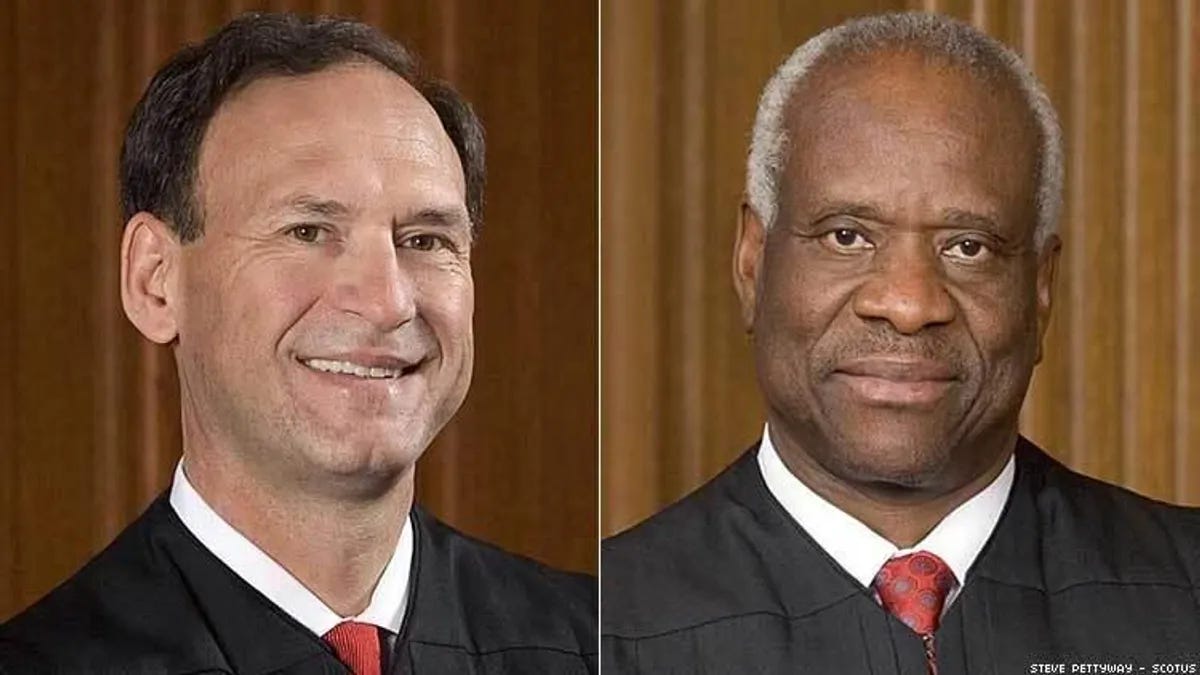Alito and Thomas Dissent in A.A.R.P. v. Trump: A Critique of Judicial Overreach
In a forceful dissent in A.A.R.P. v. Trump (2025), Justices Samuel Alito and Clarence Thomas lambasted the Supreme Court’s midnight order granting emergency injunctive relief.
In a forceful dissent in A.A.R.P. v. Trump (2025), Justices Samuel Alito and Clarence Thomas lambasted the Supreme Court’s midnight order granting emergency injunctive relief under the All Writs Act, 28 U.S.C. §1651. Issued on April 19, 2025, the order prohibited the government from removing a loosely defined “putative class of detainees” subject to a March 2025 Presidential Proclamation invoking the Alien Enemies Act. Alito, joined by Thomas, argued that the Court’s decision was premature, jurisdictionally flawed, and procedurally improper.
The case originated from a habeas corpus petition filed in the Northern District of Texas, representing noncitizens detained under the Presidential Proclamation addressing an alleged “invasion of the United States by Tren De Aragua.” Petitioners sought a temporary restraining order (TRO) to prevent removals, asserting that the District Court “constructively” denied their request by failing to rule within a 45-minute deadline they imposed on Good Friday. After filing a notice of appeal, they sought emergency relief from the Supreme Court, which granted a class-wide injunction without awaiting lower court rulings or government response.
One, the dissent challenged the Supreme Court’s jurisdiction to issue the order. The All Writs Act does not independently confer jurisdiction but merely aids existing statutory authority. For the Supreme Court to act, the Fifth Circuit needed jurisdiction over the petitioners’ appeal, which depended on whether the District Court’s inaction constituted a denial of a preliminary injunction. Since the petitioners appealed a “constructive” TRO denial—an order not appealable under 28 U.S.C. §1292(a)(1)—the Fifth Circuit correctly ruled it lacked jurisdiction. This jurisdictional gap rendered the Supreme Court’s intervention legally suspect.
Two, the petitioners’ failure to exhaust lower court remedies further undermined the Court’s action. Federal Rule of Appellate Procedure 8(a)(1) mandates seeking emergency relief in the District Court before appealing. The petitioners’ 45-minute ultimatum to the District Court, followed by a rapid appeal, did not satisfy this requirement. The District Court noted that the appeal divested its jurisdiction, halting its planned ruling. This hasty escalation bypassed essential procedural safeguards, weakening the basis for Supreme Court involvement.
Three, the Supreme Court’s precipitous action disregarded judicial norms. Despite being informed that the Fifth Circuit was preparing to rule, the Court issued its order within eight hours of receiving the application. Supreme Court Rule 23.3 limits such interventions to extraordinary circumstances after lower courts have acted. By acting prematurely, the Court deprived itself of lower court insights, undermining the deliberative process critical to sound judicial decision-making.
Four, the absence of a government response compounded the Court’s error. The Court relied exclusively on the petitioners’ filings, without input from the government in any court. The District Court had granted the government 24 hours to respond, but the petitioners’ appeal nullified this opportunity. Acting without adversarial briefing left the Court uninformed about critical factual and legal issues, a significant procedural misstep highlighted by the dissent.
Five, the petitioners’ claim of imminent removal lacked substantial evidence. In a related case, J.G.G. v. Trump, a government attorney confirmed no deportations were planned for April 18 or 19, 2025, undercutting the urgency of the petitioners’ allegations. The dissent stressed that All Writs Act injunctions require “indisputably clear” legal rights and exigent circumstances, standards not met by the speculative harm asserted in this case.
Six, the Court’s grant of class-wide relief was legally dubious. The District Court never certified a class, and the Supreme Court has not recognized class relief in habeas proceedings. Issuing a broad injunction for an undefined “putative class” lacked precedent and exceeded the Court’s authority, raising serious questions about the propriety of such expansive relief.
Seven, the Court’s unexplained, midnight order epitomized judicial overreach. Issued without justification or precedent, it flouted established standards for emergency relief. The dissent argued that such actions erode judicial legitimacy, particularly when taken without jurisdictional clarity or robust evidence. Alito and Thomas invoked Trump v. J.G.G. (2025), to underscore that both the Executive and Judiciary must adhere to legal processes. The dissent in A.A.R.P. v. Trump highlights the perils of judicial haste in complex immigration cases. By issuing a questionable order without proper jurisdiction, lower court input, or evidentiary support, the Court risked overstepping its role. This case may prompt further examination of the All Writs Act’s limits and the scope of habeas relief in class-based claims.



Andrea,
It's Good To See Who Are The True Constitutionalists.
I Am So Dissapointed In Cavanagh, Gorsuch, And Amie Comie Barrett. They Were Hopefuls.
So Sad, Glod Bless America At These Times.
And Hopeful The Conclave Gives Us A Conservative Pope.
And The One That I Had To Email The Vatican With My Dissaproval Of Pope's Sticking His Nose In Our Immigration Policy And Handling Of Illegal Aliens.
Bless You